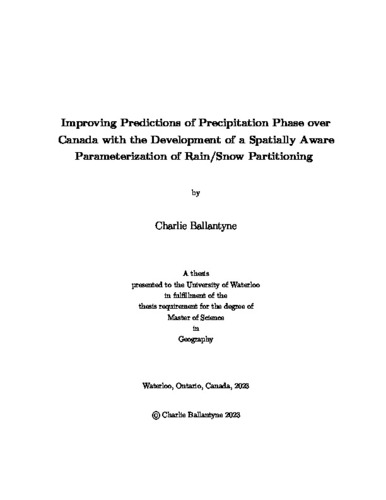| dc.description.abstract | Partitioning precipitation into rain or snow is an important aspect of hydrologic and
climatological modelling, affecting a wide variety of downstream processes (Harpold et al.,
2017). Current conventional methods typically rely on surface temperature, either as a
strict threshold or to inform a probability function which predicts a 0% chance of rain
at one temperature to 100% chance of rain at another (Jennings et al., 2019, Feiccabrino
et al., 2015). However, recent studies have shown that variables such as wind, pressure,
humidity, and atmospheric profiles of temperature can all have a significant effect on pre-
cipitation phase at the surface (Wang et al., 2019, Sims and Liu, 2015, Jennings et al.,
2018). This study utilized CloudSat data of precipitation phase and associated environ-
mental variables ground-truthed at ECCC stations across Canada to build an improved
statistical parameterization of precipitation phase. Our results showed that using a ran-
dom forest model with atmospheric profiles of wetbulb temperature in addition to surface
wetbulb temperature, elevation, and wind resulted in a probability of detection of 97.8%
across the -1, 4°C temperature interval, compared to a probability of detection of below
80% across the same interval for conventional methods. The random forest parameteri-
zation was also spatially robust, performing well on stations it had not been trained on.
Additionally, adding Sturm’s snow classes as an indicator variable to the model did not
result in any significant improvement, indicating that a model trained on all available data
is adequately able to capture spatial variability in rain-snow partitioning across the study
area. | en |

